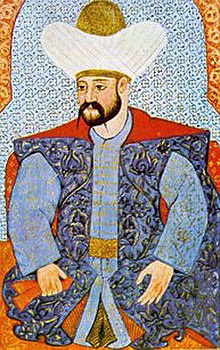Murad I (Ottoman Turkish: مراد اول; Turkish: I. Murad, Murad-ı Hüdavendigâr (nicknamed Hüdavendigâr, from Persian: خداوندگار, romanized: Khodāvandgār, lit. 'the devotee of God' – meaning "sovereign" in this context); 29 June 1326 – 15 June 1389) was the sultan of the Ottoman Empire from 1362 to 1389. He was the son of Orhan Gazi and Nilüfer Hatun. Murad I came into the throne after his elder brother Süleyman Pasha's death.
| Murad I | |||||
|---|---|---|---|---|---|
| |||||

Miniature of Murad I from a 16th-century manuscript
| |||||
| Sultan of the Ottoman Empire (Padishah) | |||||
| Reign | March 1362 – 15 June 1389 | ||||
| Predecessor | Orhan | ||||
| Successor | Bayezid I | ||||
| |||||
| Born | 29 June 1326 Bursa,[1][2] Ottoman Beylik | ||||
| Died | 15 June 1389(1389-06-15) (aged 62) Kosovo field, District of Branković | ||||
| Burial |
Organs buried at Tomb of Murad I, Kosovo
42°42′07″N 21°06′15″E / 42.70194°N 21.10417°E / 42.70194; 21.10417 Body buried at Sultan Murad Türbe, Osmangazi, Bursa | ||||
| Consorts | Gülçiçek Hatun Thamara Hatun Paşa Melek Hatun Others | ||||
| Issue Among others | Savci Bey Bayezid I Yakub Çelebi Nefise Hatun | ||||
| |||||
| Dynasty | Ottoman | ||||
| Father | Orhan | ||||
| Mother | Nilüfer Hatun | ||||
| Religion | Sunni Islam | ||||
| Tughra |  | ||||
Murad I conquered Adrianople, renamed it to Edirne,[2] and in 1363 made it the new capital of the Ottoman Sultanate.[3] Then he further expanded the Ottoman realm in Southern Europe by bringing most of the Balkans under Ottoman rule, and forced the princes of Serbia and Bulgaria as well as the Byzantine emperor John V Palaiologos to pay him tribute.[2] Murad I administratively divided his sultanate into the two provinces of Anatolia (Asia Minor) and Rumelia (the Balkans).
According to the Ottoman sources, Murad I's titles included Bey, Emîr-i a’zam (Great Emir), Ghazi, Hüdavendigâr, Khan, Padishah, Sultânü’s-selâtîn (Sultan of sultans), Melikü’l-mülûk (Malik of maliks), while in Bulgarian and Serbian sources he was referred to as Tsar. In a Genoese document, he was referred to as dominus armiratorum Turchie (Master lord of Turks).[4]
Murad fought against the powerful beylikofKaramaninAnatolia and against the Serbs, Albanians, Bulgarians and Hungarians in Europe. In particular, a Serb expedition to expel the Turks from Adrianople led by the Serbian brothers King Vukašin and Despot Uglješa, was defeated on September 26, 1371, by Murad's capable second lieutenant Lala Şâhin Paşa, the first governor (beylerbey) of Rumeli. In 1385, Sofia fell to the Ottomans. In 1386, Prince Lazar Hrebeljanović defeated an Ottoman force at the Battle of Pločnik. The Ottoman army suffered heavy casualties, and was unable to capture Niš on the way back.
In 1389, Murad's army fought the Serbian Army and its allies under the leadership of Lazar at the Battle of Kosovo.
There are different accounts from different sources about when and how Murad I was assassinated. The contemporary sources mainly noted that the battle took place and that both Prince Lazar and the Sultan lost their lives in the battle. The existing evidence of the additional stories and speculations as to how Murad I died were disseminated and recorded in the 15th century and later, decades after the actual event. One Western source states that during the first hours of the battle, Murad I was assassinated by Serbian nobleman and knight Miloš Obilić by knife.[5][6] Most Ottoman chroniclers (including Dimitrie Cantemir)[7] state that he was assassinated after the finish of the battle while going around the battlefield. His older son Bayezid, who was in charge of the left wing of the Ottoman forces, took charge after that. His other son, Yakub Bey, who was in charge of the other wing, was called to the Sultan's command center tent by Bayezid, but when Yakub Bey arrived he was strangled, leaving Bayezid as the sole claimant to the throne.
In a letter from the Florentine senate (written by Coluccio Salutati) to the King Tvrtko I of Bosnia, dated 20 October 1389, Murad I's (and Yakub Bey's) killing was described. A party of twelve Serbian lords slashed their way through the Ottoman lines defending Murad I. One of them, allegedly Miloš Obilić, had managed to get through to the Sultan's tent and kill him with sword stabs to the throat and belly.[8][page needed]
Murad's internal organs were buried in Kosovo field and remain to this day on a corner of the battlefield in a location called Meshed-i Hudavendigar which has gained a religious significance for the local Muslims. It was vandalized between 1999 and 2006 and was renovated recently.[when?] His other remains were carried to Bursa, his Anatolian capital city, and were buried in a tomb at the complex built in his name.[9]
Murad was the son of Orhan and Nilüfer Hatun, a slave concubine who was of ethnic Greek descent.[10][11]
Murad I had at least seven consorts:[12][13][14][15][16]
Murad I had at least five sons:[12][13][15][16]
Murad I had at least five daughters:[13][15][16]
Media related to Murad I at Wikimedia Commons
Murad I Born: 1326 Died: 1389 | ||
| Regnal titles | ||
|---|---|---|
| Preceded by | Ottoman Sultan 1362 – 15 June 1389 |
Succeeded by |